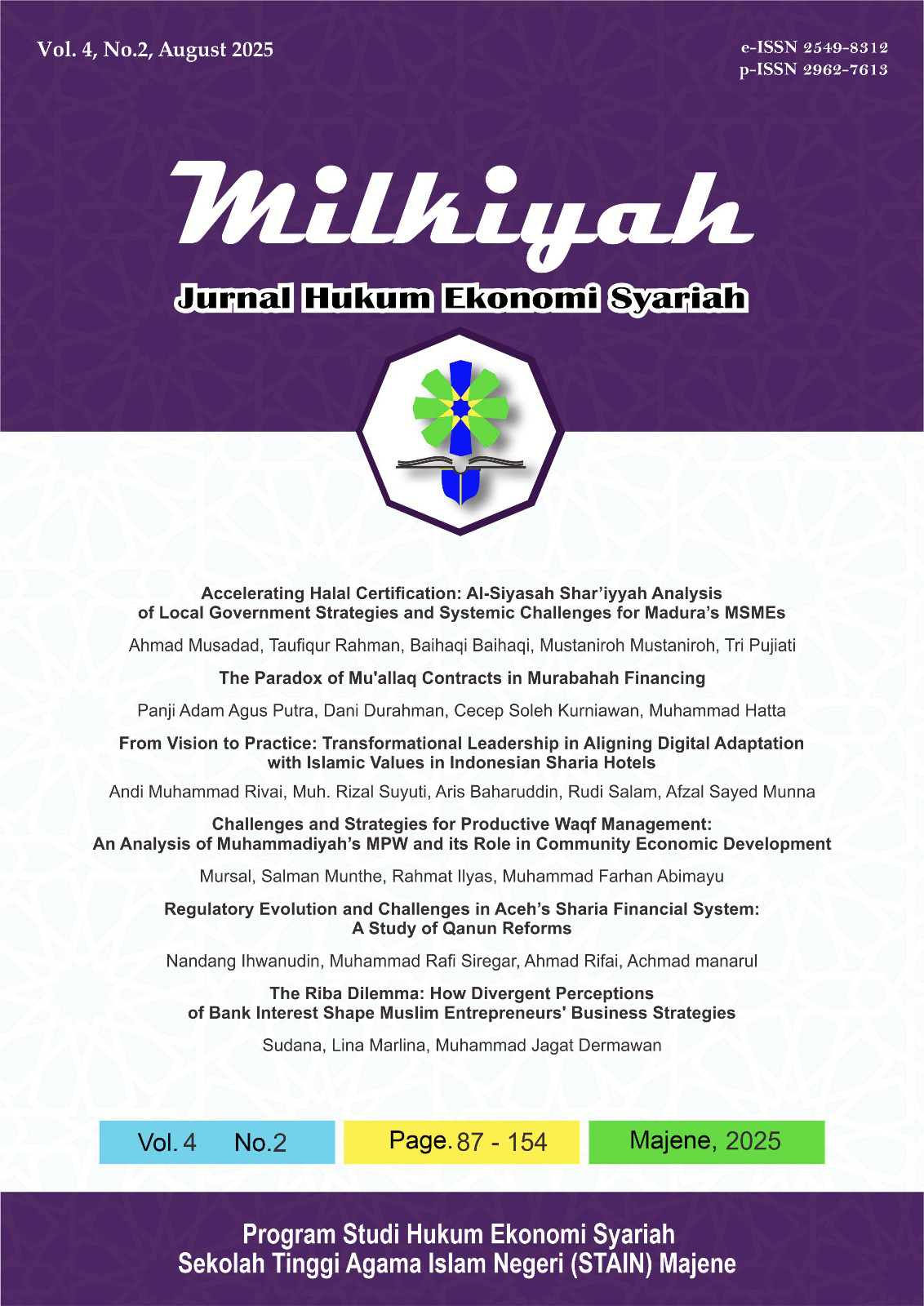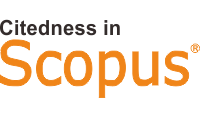The Riba Dilemma: How Divergent Perceptions of Bank Interest Shape Muslim Entrepreneurs' Business Strategies
DOI:
https://doi.org/10.46870/milkiyah.v4i2.1595Keywords:
Bank Interest, Business, Muslim Entrepreneurs, Perception, RibaAbstract
This study explores the diverse perceptions among Muslim entrepreneurs in Indonesia regarding bank interest and its influence on business decision-making. While some entrepreneurs view bank interest as usury (haram interest), which is prohibited in Islam, others do not, resulting in very different business strategies. Using a qualitative phenomenological approach, data was collected through in-depth interviews with purposively selected participants and analysed using NVivo. The findings reveal two distinct perspectives. The first group views bank interest as Riba, and their business decisions actively avoid conventional banking facilities. They prefer self-financing or community-based financing with profit-sharing principles, are more selective in choosing business partners, and may delay expansion. This group views the difference between Islamic banks and conventional banks as merely a difference in terminology and maintains strong community ties with relatively low financial pressure. This study reveals the evolution of public perception regarding usury in the modern financial system, highlighting how religious interpretations adapt to contemporary economic dynamics while influencing the financial behaviour of the faithful.
References
Adeleye, B. N. (2020). Unbundling interest rate and bank credit nexus on income inequality: Structural break analysis from Nigeria. Journal of Financial Regulation and Compliance, 29(01), 63–78. https://doi.org/10.1108/jfrc-04-2020-0035
Adomako, S., Frimpong, K., Amankwah-Amoah, J., Donbesuur, F., & Opoku, R. A. (2021). Strategic decision speed and international performance: the roles of competitive intensity, resource flexibility, and structural organicity. Management International Review, 61(1), 27-55. https://doi.org/10.1007/s11575-021-00439-w
Ahamed, N. (2020). Time Value of Money: Concepts and Applications. Indian Journal of Finance, 14, 37–43. https://doi.org/10.17010/ijf/2020/v14i5-7/153323
Al-Awlaqi, M. A., & Aamer, A. (2022). Islamic financial literacy and Islamic banks selection: An exploratory study using multiple correspondence analysis on banks’ small business customers. International Journal of Emerging Markets, 18(12), 6285–6299. https://doi.org/10.1108/ijoem-09-2021-1354
Alfeus, M., Grasselli, M., & Schlogl, E. (2020). A consistent stochastic model of the term structure of interest rates for multiple tenors. Journal of Economic Dynamics and Control, 114(05), 1–42. https://doi.org/10.1016/J.JEDC.2020.103861
Alhazmi, A., & Kaufmann, A. (2022). Phenomenological Qualitative Methods Applied to the Analysis of Cross-Cultural Experience in Novel Educational Social Contexts. Frontiers in Psychology, 13(07), 1–12. https://doi.org/10.3389/fpsyg.2022.785134
Alshater, M. M., Hassan, M., Khan, A., & Saba, I. (2020). Influential and intellectual structure of Islamic finance: A bibliometric review. International Journal of Islamic and Middle Eastern Finance and Management, 14(02), 339–365. https://doi.org/10.1108/imefm-08-2020-0419
Aspromourgos, T. (2024). Maximizing Profits Versus Maximizing Revenue: A Note on Adam Smith’s Invisible Hand. Review of Political Economy. 1-8. https://doi.org/10.1080/09538259.2024.2431499
Atal, N. U., Iranmanesh, M., Hashim, F., & Foroughi, B. (2020). Drivers of intention to use Murabaha financing: Religiosity as moderator. Journal of Islamic Marketing, 13(03), 740–762. https://doi.org/10.1108/jima-07-2019-0147
Avdukic, A., & Khaleel, F. (2025). Financial Exclusion, Soft Segregation and Moral Constraints as Drivers of Entrepreneurial Activities in Scottish Muslim Immigrants. Global Policy, 16, 57-65. https://doi.org/10.1111/1758-5899.13481
Azman, N. H. N., Zulkafli, A., Masron, T. A., & Majid, A. R. A. (2023). The interconnectivity between Islamic financial literacy and financial sustainability: Evidence from Muslim micro-entrepreneurs in Malaysia. Journal of Islamic Accounting and Business Research, 16(04), 791–810. https://doi.org/10.1108/jiabr-07-2022-0191
Azmat, S., Ali, H., Brown, K., & Skully, M. (2020). Persuasion in Islamic finance. Australian Journal of Management, 46(02), 272–286. https://doi.org/10.1177/0312896220926556
Bamboulis, C. (2025). Core beliefs in cognitive behavioral therapy and stoicism. Philosophy, Psychiatry, & Psychology, 32(2), 163-177. https://doi.org/10.1353/ppp.2025.a964183
Beer, Y. (1994). The Taxation of Interest Swaps and the Financial Service Charge: Toward a Consistent Approach. Florida Tax Review, 1 (12), 729-743. https://doi.org/10.5744/ftr.1994.1122
Beutler, T., Bichsel, R., Bruhin, A., & Danton, J. (2020). The impact of interest rate risk on bank lending. Journal of Banking & Finance, 115(01), 1–20. https://doi.org/10.1016/J.JBANKFIN.2020.105797
Bolton, N. (2025). Phenomenology and psychology: Being objective about the mind. In Philosophical problems in psychology (pp. 158-175). Routledge.
BPS. (2024). West Java Economy 2024 grows 4,95 Percent (C-to-C). https://bandungbaratkab.bps.go.id/en/pressrelease/2025/02/13/1688/west-java-economy-2024-grows-4-95-percent--c-to-c-.html
Jonas, C., Micael, D., & Helge, T. (2023). Do Customer Ratings Influence Consumers Who Have Already Experienced a Product? How Memory Reconstruction and Conformity Can Reshape Product Evaluations and Perceptions. Journal of Advertising Research, 63(1), 17-29. https://doi.org/10.2501/JAR-2023-003
Calandra, D., Lanzalonga, F., & Biancone, P. P. (2024). Exploring IFRS in Islamic finance: a bibliometric and coding analysis of emerging topics and perspectives. International Journal of Islamic and Middle Eastern Finance and Management, 17(4), 711-729. https://doi.org/10.1108/IMEFM-11-2023-0444
Conard, J. W. (2023). Introduction to the Theory of Interest. Univ of California Press.
Elliott-Mainwaring, H. (2021). Exploring using NVivo software to facilitate inductive coding for thematic narrative synthesis. British Journal of Midwifery, 29(11), 628–632. https://doi.org/10.12968/bjom.2021.29.11.628
Elmassah, S., & Abou-El-Sood, H. (2021). Selection of Islamic banking in a multicultural context: The role of gender and religion. Journal of Islamic Marketing, 13(11), 2347–2377. https://doi.org/10.1108/jima-05-2020-0160
Ercan, H., Karahanoglu, I., & Walter, G. (2021). Is Islamic Banking in Turkey really interest-free? Society and Economy, 43(04), 391–405. https://doi.org/10.1556/204.2021.00016
Erdmann, A., & Potthoff, S. (2023). Decision Criteria for the Ethically Reflected Choice of a Member Check Method in Qualitative Research: A Proposal for Discussion. International Journal of Qualitative Methods, 22(01), 1–11. https://doi.org/10.1177/16094069231177664
Hagger, M., & Hamilton, K. (2023). Longitudinal tests of the theory of planned behaviour: A meta-analysis. European Review of Social Psychology, 35(01), 198–254. https://doi.org/10.1080/10463283.2023.2225897
Harahap, B., & Risfandy, T. (2022). Islamic Organization and the Perception of riba (Usury) and Conventional Banks Among Muslims: Evidence From Indonesia. SAGE Open, 12(02), 1–7. https://doi.org/10.1177/21582440221097931
Harahap, H. U., & Harahap, R. A. (2023). Literature Study of Riba In Banking. International Journal of Economics and Management, 1(01), 33–40. https://doi.org/10.54209/iem.v1i01.6
Jovičić, Ž., & Pešić, M. (2024). MAKING UNCERTAIN BUSINESS DECISIONS IN THE BANKING SECTOR. Economy & Market Communication Review/Casopis za Ekonomiju i Trzisne Komunikacije, 14(2). https://doi.org/10.7251/emc2402665j
Kementerian Agama . (2019). Al-Quran dan Terjemahannya. Jakarta: Lajnah Pentasihan
Klein, P. O., & Turk-Ariss, R. (2022). Bank Capital and Economic Activity. Journal of Financial Stability, 62, 101068. https://doi.org/10.1016/j.jfs.2022.101068
Latip, M. (2024). Customer innovativeness in the adoption of Islamic banking in Malaysia. International Social Science Journal, 74(254), 1463–1486. https://doi.org/10.1111/issj.12523
Lim, W. M. (2025). What is qualitative research? An overview and guidelines. Australasian Marketing Journal, 33(2), 199-229. https://doi.org/10.1177/14413582241264619
Martikainen, T., & Brekke, T. (2022). The Rejection of Interest-Based Loans among Muslim Entrepreneurs and Professionals in Finland. Journal of Muslims in Europe, 12(02), 212–227. https://doi.org/10.1163/22117954-bja10074
Miah, M. D., & Suzuki, Y. (2020). Murabaha syndrome of Islamic banks: A paradox or product of the system? Journal of Islamic Accounting and Business Research, 11(07), 1363–1378. https://doi.org/10.1108/jiabr-05-2018-0067
Minaryanti, A. A., Fitrijanti, T., Sukmadilaga, C., & Mihajat, M. (2024). The role of Sharia governance in minimizing credit risk in Islamic banking: A systematic literature review. Journal of Islamic Accounting and Business Research, 15(04), 553–568. https://doi.org/10.1108/jiabr-11-2022-0301
Morgenstern, O. (2024). The time moment in value theory. In Classics in Austrian Economics, 2 (pp. 316-340). Routledge.
Murphy, R. P. (2022). The pure time preference theory of interest. In A Modern Guide to Austrian Economics (pp. 216-237). Edward Elgar Publishing.
Mursyid, A. C. (2022). Performance Analysis of Sharia and Conventional Banks with Maqashid Sharia: Case Study of Indonesia and Malaysia in 2016-2020. Journal of Southwest Jiaotong University, 57(04), 292–304. https://doi.org/10.35741/issn.0258-2724.57.4.26
Öhlén, J., & Friberg, F. (2023). Empirical phenomenological inquiry: Guidance in choosing between different methodologies. Global Qualitative Nursing Research, 10, 23333936231173566. https://doi.org/10.1177/23333936231173566
O’Sullivan, M. (2020). Interest, Usury, and the Transition from “Muslim” to “Islamic” Banks, 1908–1958. International Journal of Middle East Studies, 52(02), 261–287. https://doi.org/10.1017/S0020743820000239
Rehman, A. U., Aslam, E., & Iqbal, A. (2022). Intellectual capital efficiency and bank performance: Evidence from islamic banks. Borsa Istanbul Review, 22(1), 113-121. https://doi.org/10.1016/J.BIR.2021.02.004
Setiawan, R. (2023). Avoidance of Riba-Based Loans and Enhancement of Quality of Life: An Indonesian Context Analysis. Religions, 14(11), 1–11. https://doi.org/10.3390/rel14111376
Sinnaiah, T., Adam, S., & Mahadi, B. (2023). A strategic management process: the role of decision-making style and organisational performance. Journal of Work-Applied Management, 15(1), 37-50. https://doi.org/10.1108/JWAM-10-2022-0074
Sohail, H., & Arshed, N. (2024). The potential of Islamic financing in making financial development more entrepreneurship friendly. Journal of Islamic Accounting and Business Research, 15(02), 1–30. https://doi.org/10.1108/jiabr-07-2023-0206
Sutrisno, S., & Widarjono, A. (2022). Is Profit–Loss-Sharing Financing Matter for Islamic Bank’s Profitability? The Indonesian Case. Risks, 10(11), 1–12. https://doi.org/10.3390/risks10110207
Syah, D., & Rahmadani, G. (2024). The Profit-Sharing System in Financing Islamic Banking. Qubahan Academic Journal, 04(01), 300–309. https://doi.org/10.48161/qaj.v4n1a198
Tarmizi, E. (2013). Harta Haram Muamalat Kotemporer. Berkat Mulia Insani.
Tentama, F., & Kurniawati, K. (2024). Entrepreneurial Readiness of Young Muslim Entrepreneurs: The Role of Need for Achievement, Family Support, and Entrepreneurial Interest. Islamic Guidance and Counseling Journal, 07(02), 1–19. https://doi.org/10.25217/0020247473200
Turner, J. K., & Lopez, A. (2024). Sizeism Among Fat and Big Men: A Phenomenological Study. The Counseling Psychologist, 52(08), 1342–1371. https://doi.org/10.1177/00110000241293482
Zaal, R. O., Jeurissen, R. J., & Groenland, E. A. (2019). Organizational architecture, ethical culture, and perceived unethical behavior towards customers: Evidence from wholesale banking. Journal of Business Ethics, 158(3), 825-848. https://doi.org/10.1007/s10551-017-3752-7
Downloads
Published
How to Cite
Issue
Section
License
Copyright (c) 2025 Sudana, Lina Marlina, Muhammad Jagat Dermawan

This work is licensed under a Creative Commons Attribution-ShareAlike 4.0 International License.

















